
I apologize for bad
English.
The page is in a stage of manufacturing.
The Soviet heavy planes last thirty years were " in a shadow " of intercontinental ballistic rockets, which made a basis of strategic power of the Soviet Union. After acceptance on arms in the beginning 50 years Tu-95, M-4 and 3M up to the end 80 in USSR has not come in build any plane of this class. Only recently machines of this class have filled up Tu -160. However Soviet heavy planes continued to develop: the interesting researches were carried out, the original projects were developed.
The first place in a class of average supersonic heavy planes for long years became a design bureau Tupolev. But created by him(it) Tu-22 not only could not supersede дозвуковой Tu-16, but also make to it(him) a serious competition. Only in middle 70 years on arms has acted really supersonic average Tu-22М, received the name "Backfaier"".
Undressed of the world on spheres of influence having held has resulted that the creation of the strategic weapon of an attack capable to amaze of the purpose direct in territory of the probable opponent, became the basic priority of strategy USSR and USA. In search of the suitable carrier for intercontinental delivery of a nuclear charge the best minds till both parties of ocean were engaged. In USSR such works be ordered on three basic directions: the design bureau Korolev and Jngel was developed by strategic ballistic rockets (R-7 both R-9 in first and R-16 in the second bureau); a design bureau Lavochkin and Msishev - беспилотные intercontinental planes - shells (La-350 "Burj" and M-40 "Buran"); in the third direction - strategic planes - were engaged онструкторское a bureau Mjsishev, Tupolev and Bartini, and at the end of 50 years and "firm" Chibin and Beriev.
The greatest successes the design bureau - 23, under a management(manual) Vladimir Mjsishev has achieved. After several years of the compelled break of March 24, 1951 it has renewed work specially for creation of the strategic plane M-25. After it have renamed in M-4 (code of NATO "Bizon"). Since 1955 the plane was produced in lots at an airfactory ╪23 in Moscow, and the collective collective of a design bureau has begun creation of the supersonic machine.
The first projects of supersonic planes V.Mjsishev to so-called " to family 30 ". The projects M-30 and M-31 were faster average planes with take-off weight less than 100 т. In the same weight category was created and М-33, created on the circuit without a tail. M-32 and M-34 were heavy planes, but had no intercontinental radius of action. So, M-32 had settlement range of 8000 kms, speed 1350 kms / hours and take-off weight about 180 т. M-34 had range of 8700 kms and maximal speed of 1850 kms / ч.
Then there were projects of family "50", one of which became famous M-50. As the conducting designer of the machine have nominated G.Nazarov. The settlement speed of flight of the plane should make 1950 kms / ч, and practical ceiling - 16500м. Dimensions of the machine: length 59,2 м, scope of a wing - 32,5 м, height - 10,7 m.

М-50 Before the first start
Distinctive feature M-50 became that on it literally all - from engines up to tire covers of wheels - was made again. The most important features of aerodynamic configuration М-50 became a thin triangular wing (relative thickness - within the limits of 3,5 - 3,7 %) with a break on forward кромке and wholly turning a horizontal tail. The approach to designing the case assembled from large-sized panel elements was new also
In a design the chassis have repeated the principle which has been checked up on M-4 and 3M - the bicycle circuit with a sliding forward support. The problem of braking on run - with the help of a hydrodrive from cases was rather originally solved four were put forward steel beams, similar to a ski. At their friction about concrete the whole sheaves of sparks were formed, but such way of braking has appeared very effective.


Variants M-50
On М-50 for the first time in USSR the automatic system of regulation of a situation of a centre of gravity in flight was used by swapping fuel between case and groups of wings of tanks. The necessity for it has arisen because at transition to supersonic speed the character of a flow of a wing changes, resulting to occurrence dive of the moment. Also for the first time in domestic practice at the expense of use of achievement of electronics the crew of the heavy plane managed to be reduced up to two men.
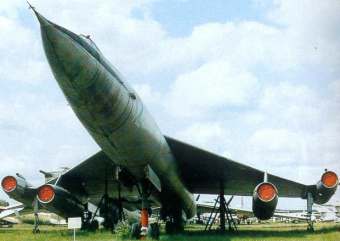
Problematic there was a creation of power installation. As the plane should make long flight on supersonic speed, the engines with draft without foce not less 17000kgs were required. Most suitable there was an engine developed in a design bureau P.Zubcha. His(its) engines "16-17" promised to have the specific charge of fuel no more than 1,1-1,12 kg / dh at flight with speed appropriate M=1,8, and static draft 166,7kH (17000kgs)..
One of the first serious researches became search of optimum accommodation of engines. It was required to supply the best arrangement of entrance channels of air, to minimize aerodynamic resistance and maximum to simplify a design.
October 27, 1959, the pilot Nikolai Goriajnov has lifted in air M-50. As on the moment of a beginning of tests the engines of a design Zubcha were not lead up yet, on the prototype have established less powerful four motors VD-7 (on 9750 kgs) design Dobrinin. For increase of draft up to 14000 kgs two engines under a wing equipped force with chambers. However it has not helped: M-50 and has not overcome speed of a sound having achieved speed in М=0,99. Except for this failure and one fine failures the other tests passed smoothly. In west, after effective display above air station in Тушино, in support of two Instants - 21, the plane has impressed, to it have appropriated a code of NATO Bounder and even spoke about serial manufacture. But at this time, autumn of 1960, V.Mjsishev have nominated as the chief CAGI, and a design bureau - 23 have disbanded. Collective have subordinated V.Chelomei, creating space engineering, and М-50 subsequently have transferred in a museum in Монино. The universal enthusiasm for ballistic rockets, seemed " has put a point " on strategic aircraft.
But before disbandment of a design bureau of work on the plane went by a complete course. At once after M-50 designing its updating M-52 began, on which the engines under a wing were established under a significant corner to a plane of a wing, and external had some other kind. On M-52 have established additional horizontal rudders at top of Kiel, have carried out internal completions. Was planned to establish system of swapping of fuel in air. The arms consist of four rockets of a class "air - ground". The first copy M-52, equipped by engines "16-17", was constructed, however was not tested and has gone on demolition.
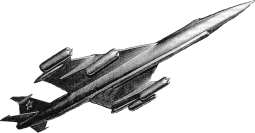
M-52
Only on a paper and in models there was a project M-54. From M-50 it differed by a wing with a small acuteness on back кромке. On it various variants of an arrangement of engines also were analyzed.
In 1960 designing the strategic plane M-56, with крейсерской by speed in limits M=2,5-3,25, range up to 10000 kms and take-off weight about 250 т has terminated. It had aerodynamic компановку "duck" from two vertical rudders. But it was no habitual "duck". On small speeds the forward horizontal rudder was freely focused and did not influence the characteristics of stability. At transition to supersonic speed horizontal оперение was fixed. Longitudinal stability of the machine thus was provided at change of distribution of aerodynamic forces on a wing. This decision has allowed to refuse complex system of swapping of fuel.

One of the first variants M-56

Final variant M-56
On base M-56 its passenger variant M-55, in models M-55A, M-55B, M-55V, distinguished by a dimension and number of engines was studied. First of them was designed for 40 passengers, second - on 85, and third - on 120. M-55A had two engines, M-55B - four, and M-55V - six.

The passenger plane M-55
Under the code М-60 the plane with nuclear power installation was developed which was projected with a design bureau A.Lulka. This machine has not left for a stage of the project.
There was one more almost improbable project - strategic plane - flying boat M-70. This plane the sowing in the given point of ocean, could fill up a stock of fuel from an emerged submarine and to continue a way.

The plane - flying a boat M-70
In 1967 the militarians, having realized, that the curtailing of the airprogram was premature, have put forward the following requirements: range of 11000-13000 km at flight with small speed at small height; the same range at flight with speed of 3200-3500 km/h at height more than 18000m; range 16000-18000 km at flight with speed of 800-900 km/h at height 10000m.
In the answer per 1967-68 the project M-20 has appeared. There were some its variants: one under the circuit "duck" with a triangular wing, second - "duck" with a wing of changeable geometry, third externally resembled Tut - 160, there were also other variants. The basic competitor M-20 became T-4MS of development of a design bureau Suhoj. During competition was found out what to satisfy with all тактико-technical requirements it is impossible. Military Air Force have reconsidered them and at a new stage the struggle has inflamed between M-18 of a design Mjsishev and Tut - 160 of a design Tupolev, and the design bureau Suhoi has curtailed works on strategic aircraft.
The design bureau has left with the project of a heavy flying boat LL-600 with a wing of the triangular form located on the circuit " a flying wing ". Expected to equip it(him) with eight jet engines. Take-off weight of the monster was planned 1000 t, and speed - 900 km/h. The passenger variant on 2000 men was in parallel developed.
The project planned creation strategic flying of the boat - plane A-57 and device, located on it, Chibin RSS. The boat - carrier had settlement take-off weight 250 t, the speed up to 2000 km/h and range up to 14000km. The power installation consist of five engines NK-10B of a design Kuznichov by draft on 26000 kg or, temporarily, NK-6 by draft on 22500 kg. The engines were placed in a uniform package in a tail part of the case between two vertical Kiel. From above on A-57 the plane - shell РСС fastened. Besides it A-57 itself could bear a three-ton nuclear bomb (product "6"). On those times the equipment of a flying boat was represented by top of perfection: a radar SBR-1, system of statement of active handicapes "Rose" и "Broom", station of passive handicapes TRS-45, navigating complex "Wind", complex of communication "Planet". For communication with a submarine the tanker planned installation of a hydroacoustic complex "Ohotsk".
After creation Tu-95 in a design bureau be ordered researches on creation of the supersonic plane of a similar class. But to this time at the chief USSR N.Hrushev has developed the quite certain opinion on a role and destiny of planes, and to convince him was business not only useless, but also dangerous. The task, in opinion Tupolev, consist only in " filling of a place " during persecutions on aircraft. On crisis 50 and 60 years the design bureau Tupolev has created the project "135" with prospective take-off weight 205 t and normal speed of 2200 km/h. Externally plane reminded M-56 or American XB-70, having the aerodynamic circuit "duck" with a triangular wing. The power installation consist of four engines NK-6 by draft on 22500kg. The passenger variant of this machine was considered also. It in a basis of the first studies Tu-144.
The characteristics of the new strategic
plane developed in USSR on a competitive basis in the beginning 60 years, were determined
by Research institute of air systems in Moscow on the basis of the analysis of tasks, for
which performance such plane intended. Basic feature last became accent(stress) on
destruction of the not strategic shock means, directed against USSR, first of all -
American aircraft carriers. The attack on an aircraft carrier should be carried out
without call in a zone it(him) in a zone of a defeat by aircraft. Proceeding from such
task, the range of the plane was determined in 4000 kms, and radius of action - in 2000
kms plus of 1500 kms of range of start-up of rockets "air - ship". In view of
necessity of minimization of time of reaction from receipt of a team before drawing impact
the maximal speed of the plane was set by size М=3, and normal - М=2,8. At the same time
to the plane the requirement was presented to be based not only on concrete, but also on
earth landing strips.
Three design bureaues have taken part in the announced competition: the design bureau - 156 A.Tupolev, design bureau P.Suhoi and design bureau - 115 A.Jakovlev. Tupolev was presented with the project "135". Jakovlev has offered the project of the plane Jak-33, representing by itself the high plan with a triangular wing, classical tail and engines located under wings. The basic constructional material assumed heat resisting steel. Simultaneously two design bureaues on construction of motors have offered the engines: S.Tumanskij - R-15 (developed during this period for Mig-25) and P.Kolesov - R-36-41 (this engine also has received preference). The rocket, controlled against the ships, X-45 was created by(with) collective A.Berezniak.
In a design bureau O.Suhoi the first general views of the plane designated T-4, in December, 1961 has executed Alehander Poliakov. Soon as conducting designer of the project have nominated Oleg Samoilovich, and spring of 1962 coordination of works on this subjects have assigned to the main designer Naum Cherniakov. The code T-4 was confidential, and for official correspondence have accepted the name " a product 100 ". This figure has appeared because rough weight of the first variant T-4 made about 100 t.
The commission has rejected the projects Tupolev and Jakovlev, having concentrated the attention on T-4. However Dry has borrowed other position: having the conclusion of a competitive commission, he was not going to surrender and has achieved allocation of necessary means on creation of the plane.
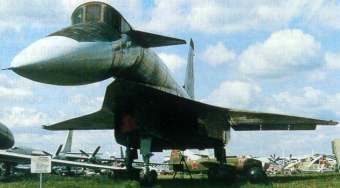
T-4 "Hundred"
New word in an airstructure became a cabin without the review in normal flight - management of the plane was carried out only on devices. For maintenance of the review on rise and landing nose the part of the case deviated downwards.
In December, 1965 the variant of the plane was authorized final, 33-rd under the account, and then the Decision of government on construction of the machine has appeared. For this purpose five years' term was allocated.
On " a product 100 " most advanced was established on that time a complex of the equipment and arms. The plane had astroinertial navigating system with a conclusion of the current rule(situation) of the plane to a card, проецируемую on the screen in a cabin of the pilots. The arms T-4 consist of two rockets X-45 with range of start-up in 1500 km. For conducting investigation there were локатор of the lateral review, infra-red gauges and photoequipment. Due to high automation of processes of management of the plane the crew of the plane consist all of two men.
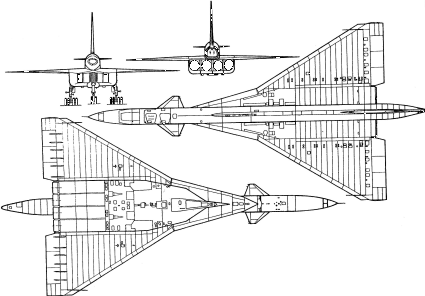
T-4 ("100")
Scope of a wing 22,7 m
Length 44,5 m
Height 11,95 m
Take-off weight of 135000 kg
Ceiling 23000 m
The maximal speed of 3200 km/h
Normal speed of 3000 km/h
The maximal range of 7000 km
The situation T-4 was primary rather shaky - such plane really it was not required. The same tasks and with not by smaller efficiency could be decided(solved) by(with) less complex(difficult) machine, as for example туполевский " the project 145 ", famous later Tu-22M.
In October, 1974 after 10 successful starts the flights have stopped. In 1982 the plane was transferred to a museum Monino.

In 1967 the militarians again "have recollected" strategic aircraft. The new competition on the multi-purpose intercontinental shock prospecting plane was announced. As a push the decision of USA has served to develop the project AMSA (Advanced Manned Strategic Aircraft) - future(next) B-1.
In a design bureau Suhoi the new plane has received the name T-4MS. The machine has received the code - " a product 200 " - by analogy to "hundred" because of take-off weight which is coming nearer to 200 t. The new plane had the bearingg) case, from which contours the engines, nose of the case, rotary consoles of a wing and two ых of a rudder acted only. Such configuration has allowed to reach high parameters of aerodynamic quality, and large volumes of the case - to ensure necessary reserve of fuel and optimum to arrange the equipment. The rotary consoles of a wing could change стреловидность from 30 up to 72 degrees. The machine предпологалось to equip with four engines NK-101 by draft till 20 hardware having a variable degree two contours. Despite of a potentially high technological level, T-4MS and has remained on a paper.
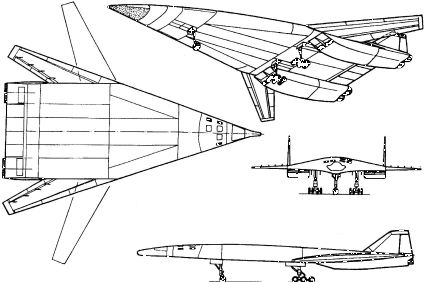
T-4MS
Scope of a wing 40,8 m
Length 41,7 m
Height 8,0 m
Take-off weight of 170 000 kg
Ceiling 24000 m
The maximal speed of 3200 km/h
The maximal range of 11000 km
The maximal range at speed of 3000 km/h of 7500 km
The ending of competition was held in 1975 between the project Mjsishev M-18, externally rather similar on B-1, and Tu-160. As best have recognized the plane Mjsishev, however... Preference has received That - 160.